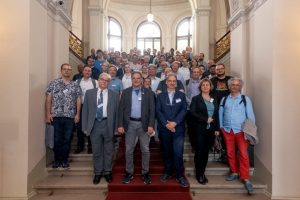The Experimental Particle Physics group at Ghent University group has recently been broadened into a group working on Experimental Particle Physics and Gravity with the inclusion of gravitational waves. The Gravity Ghent Group is a sub-division pioneering this research. Members of the group are involved with Virgo instrumentation, LIGO-Virgo-KAGRA data analysis, and Observational Science with the Einstein Telescope. Ghent University is a founding partner of the ETPathfinder project, and members of the group take part in the instrumentation developments related to this facility in Maastricht. Ghent University is also one of the initial members of the recently-established Einstein Telescope Collaboration. A brief description of the gravitational wave research in Ghent University can be found below. Detailed information is also available on the webpage of the Gravity Ghent Group.
Advanced Virgo

Advanced Virgo is an interferometric gravitational wave detector located in Cascina, near Pisa, in Italy. The data from the Virgo detector is analyzed together with the detector from the Advanced LIGO detectors in the USA and the KAGRA detector in Japan.
Ghent involvement
Ghent University is a member of the Virgo Collaboration as part of the Belgian BelGrav Group.
The Ghent Gravity Group is involved in Virgo instrumentation and data analysis:
- Characterization of the phase camera of Advanced Virgo
- Data analysis in the context of compact binary coalescences and unmodelled bursts from supernovae
ETpathfinder
Etpathfinder is a R&D research facility funded by Interreg Vlaanderen-Nederland and located in Maastricht.

Aim of the project
Next generation gravitational wave detectors, like the Einstein Telescope, will introduce a number of new technologies never used before in such kind of detectors and for which a preliminary study and testing is then necessary.
Etpathfinder aims to test some of these new technologies. Specifically, it will be focused on developing prototype and testing:
- Cryogenic temperatures (120K and 15K)
- New mirror material (Silicon)
- New laser wavelength (1550nm and 2100nm)
- Advanced quantum noise reduction techniques
Ghent involvement
Ghent University is one of the founding partners of ETpathfinder (additional information can be found here).
The Ghent Gravity Group is involved in its realisation for the following aspects:
- Vacuum system construction
- Design and construction of parts of the Suspension System prototype
- Developing and testing photodetectors for 2µm wavelength
- Developing of the Output Mode Cleaner for 2µm wavelength
Einstein Telescope
The Einstein Telescope is a proposed underground infrastructure to host a third-generation, gravitational-wave observatory. It builds on the success of current, second-generation laser-interferometric detectors Advanced Virgo and Advanced LIGO, whose breakthrough discoveries of merging black holes and neutron stars over the past years have ushered scientists into the new era of gravitational-wave astronomy. The Belgian-Dutch border region is one of the two prospective sites for the Einstein Telescope.

Ghent involvement
Ghent University is one of the initial members of the recently-established Einstein Telescope Collaboration [NEWS].
The Ghent Gravity Group is currently involved with the Einstein Telescope via:
- the Einstein Telescope Observational Science Board:
- fundamental physics, cosmology, transient GW sources, and data analysis platform
- the ETpathfinder project